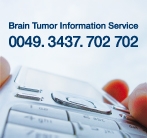Glioblastom
Glioblastom - Informationen über Therapie und Diagnose
Das Glioblastom (Glioblastoma multiforme) ist ein hirneigener Tumor, der sich aus den Gliazellen, dem Stützgewebe des Gehirns, entwickelt. Laut WHO-Klassifikation wird dieser aggressiv wachsende Tumor als Grad 4 eingestuft und gilt bis heute als unzureichend therapierbar.
Nutzen Sie von Beginn an die Hilfsangebote für Glioblastompatienten. Informieren Sie sich telefonisch unter 0341.5 90 93 96 über die Prognose, aktuelle Standards der Behandlung und informieren Sie sich über neue Therapieoptionen. Sie sind nicht allein.
Glioblastom-Broschüre jetzt kostenfrei bestellen
Histology of Glioblastoma
- features necrosis and hemorrhage
- high poliferation and fast growth
- very malignant
Epidemology of Glioblastoma
- average age between 45 and 60, but also younger patients can be affected
- twice as often in men
Symptoms of Glioblastoma
- signs of intracranial pressure, neurological failures or epileptical seizures
- headache
- dizziness
- emesis
- vision impairment
Diagnosing Glioblastoma
- very short anamnesis of weeks or a few months
- diagnosis using MRI scan, CT scan, biopsy
- irregularly, highly receptive contrast agent
- central decreased contrast enhancing (hypodense center)
- diffuse infiltration of surrounding brain tissue
- tendency to high-volume central necoris and peritumorous edema
- main location: cerebral hemisppheres and corpus callosum ("butterfly glioma")
- surrounded by an expanded white matter edema
- at diagnosis often bigger than 2 cm
- misdiagnosis: e.g. stroke
Therapy of Glioblastoma
- surgerey
- radioherapy on tumour volume and safety margin of 2 cm
- chemotherapy
- clinical trial
Therapy of Recurrent Glioblastoma
- renewed surgery
- second radiotherapy
- chemotherapy
- clinical trial
Course of Glioblastoma
- relatively fast growth with infiltration of surrounding tissue
- recurrence even after successful surgery / therapy usually within one year






